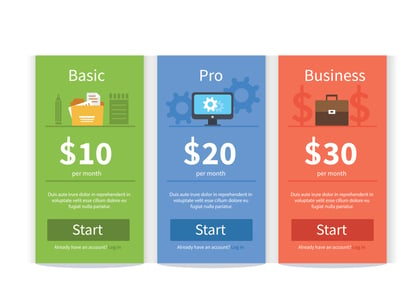Here’s a million-dollar question: Do you know how to correctly price your SaaS product?
 Some business owners believe that offering the lowest price is the secret to success, when in fact determining the value your product offers to your client is actually far more important.
Some business owners believe that offering the lowest price is the secret to success, when in fact determining the value your product offers to your client is actually far more important.
Why? Because once you understand the value that customers place on the product you are selling, you can then create pricing models that satisfy their needs.
So let’s first take a look at how you can learn the value of your products, and then how you can implement three key strategies to come up with a price that customers will happily pay every month.
How Do You Learn the Value of Your Products?
When we talk about the “value” as it relates to customers, we’re talking about what your customers perceive your product does to improve their personal or professional life. In other words value is based on this key customer question:
What’s in it for ME?
And to break it down even further, here are three areas where value is won –– or lost:
- Cost – Does the product save your customers money? Does it make them want to switch over from another product that is priced higher, but offers less features?
- Time – Does the product save your customers time? Does it eliminate a step in their business process and make their workday more efficient?
- Revenue – Does the product increase your customers’ revenue stream? This is typically tied to cost and time, because products that are affordable and that save time will likely lead to increased revenue based on less spending and increased productivity.
So now that you know what you’re looking for when it comes to the value customers place on your products, you have to find a way to obtain this information. What’s the best way to do that?
Well, if you have an existing subscriber email list, you can send out a survey or questionnaire.
Your customer service agents can also obtain this information with outbound calls to your customers, and you can offer some kind of incentive to entice your consumers to provide answers.
Once you have the data you need, you can now implement these next three strategies to set your product price:
- Determine Customer Lifetime Value
Customer lifetime value (CLV) is a concept that’s incredibly important to pricing, because it tells you how much it costs to acquire a customer, and how much that customer spends relative to that acquisition cost.
Why is that important? Because it also tells you the sweet spot to spend on retaining each customer, and how much you can actually spend on each customer and still make a profit.
Calculating CLV has become a cottage industry, and there are a ton of programs that can do it for you based on a number of different variables. But for a simple example, you can calculate CLV by subtracting the monthly price for your product from the amount you spend to deliver and support that product, then multiply that number by the length of time you expect to keep each customer.
So let’s say you charge $30 a month for your SaaS product or service, and it costs you $10 to deliver and support that product every month, and the average length of time you retain a customer is 24 months. The formula would look like this:
(30 – 10) x 24 = $480
In this example, your CLV would be $480, but the key is to make sure that your CLV is higher than the cost to acquire a customer, or you will lose money. - Use the 10x Value Method
The 10x rule is another tried-and-true pricing method. Your mission –– should you choose to accept it –– is to create a product that will generate 10 times the amount it cost to buy that product.
So if your SaaS product or service generates $5,000 a month in revenue or savings to your customer, a baseline price for that product should be around $500.
Your customers are much more likely to accept the price of a product when that product is generating revenue, because it feels more like an investment than a financial burden. - Segment Your Customers In a Specific Way
When you’re trying to determine pricing for your product, it’s really important that you divide your customer base into very specific groups.
Why? Because certain segments of your customers will require more of your products and services than others.
For example, let’s say you have two customers. One is a company that has 30,000 employees and the other is a company that has 500 employees.
And let’s say they’re in the market to purchase security software from your company.
Your pricing tier for the company with 30,000 employees would have to be lower than for the one with only 500 employees, because you stand to gain much more revenue with the bigger company at a lower monthly subscription price.
Don’t treat all your customers the same way, or you’ll end up with the wrong pricing tier.
Pricing Never Ends
Pricing your SaaS products is not a one-time event.
You must constantly perform market research and solicit feedback from your customers to determine whether your pricing structure should be modified.
But by first determining the value customers place on your products, you will have a much better idea how to price them in a way that boosts your bottom line. You would also want to ensure that your pricing changes can be easily implemented in your billing system without spiralling into a large scale project.
